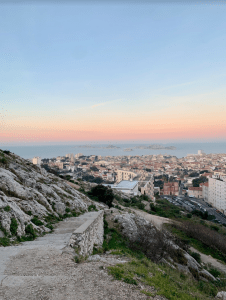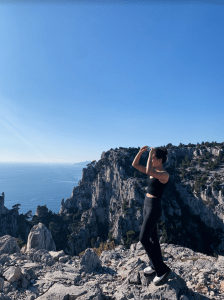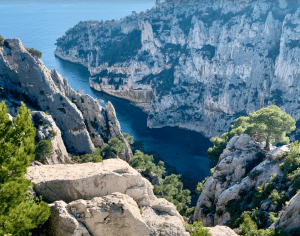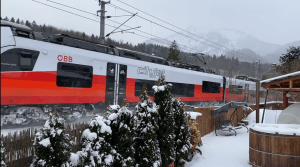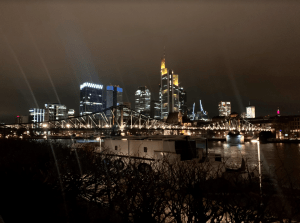Monday, March 14, 2022 | Written by Claire
After 21 hours of cancelled trains, freezing layovers, and cramped power naps, the beautiful Copenhagen skyline finally appeared in sight. I breathed a sigh of relief as I stretched out my limbs after standing on the fully reserved Danish train packed with rowdy teenagers hogging the bathroom to make Tiktoks. The journey there was nothing but chaotic. Our connecting train to Hamburg just magically disappeared into thin air and DeutschBahn just gave up on giving us housing for the night. So, we spent 2 hours bundled and starving in the Frankfurt station in Germany.
We left Thursday, arriving Friday afternoon at 4 PM then, we had all of Saturday to explore the city. We were there for a short, but pleasant time and there were several nuances about Danish society that made it characteristically different from any of the other places I’ve been to.
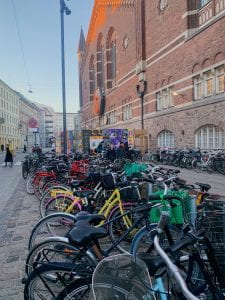 Bikes: To make our time there more efficient, we rented bikes for the day! All of the online tips said Copenhagen is a bikeable city and they were not wrong! The city was built around biking. Massive travel lanes dedicated just for bikers were sometimes wider than the car lanes themselves, and each corner was equipped with a bikers-only traffic lights. Furthermore, not only were there actual turn lanes, but there were also massive sections on the metro for people to snag a spot on their short journey. The design of the metro was interesting. To fit the width of the bikes, the middle of each train cart bowed outwards to make extra space. Inside, you could park at least 6 or 7 bikes in one car, and there were also seats on the other side for passengers as well. Even on every street corner or marketplace, there would be hundreds of bikes parked in designated bike lots, creating an array of colors that are characteristically Danish.
Bikes: To make our time there more efficient, we rented bikes for the day! All of the online tips said Copenhagen is a bikeable city and they were not wrong! The city was built around biking. Massive travel lanes dedicated just for bikers were sometimes wider than the car lanes themselves, and each corner was equipped with a bikers-only traffic lights. Furthermore, not only were there actual turn lanes, but there were also massive sections on the metro for people to snag a spot on their short journey. The design of the metro was interesting. To fit the width of the bikes, the middle of each train cart bowed outwards to make extra space. Inside, you could park at least 6 or 7 bikes in one car, and there were also seats on the other side for passengers as well. Even on every street corner or marketplace, there would be hundreds of bikes parked in designated bike lots, creating an array of colors that are characteristically Danish.
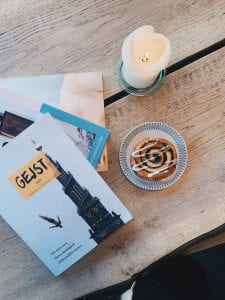
Coffee Shops: We also stopped by a quaint café that doubled as a bookstore and cozy living room. As a group, we ordered out a bundle of cinnamon rolls, bread and butter, pain au chocolat, and several cups of espresso. The aesthetic was immaculate, and the huge shelves of books that canvased the entire wall made the vibe very homey. The café itself served the pastries on different colored plates, just as if we were to eat a quick snack in someone’s home. With some people there tapping away on their laptops or grabbing a quick caffeine fix for the long day, others were sitting at wooden benches, chatting away. The entire café had such a positive vibe that reminded me of home.
Masks: One of the more “shocking” traits of Copenhagen was the lack of masks or any social distancing restrictions. On the train ride, as soon as we crossed the border out of Germany, everyone ripped off their masks and started bathing their faces in the warm sunlight that floated in from the windows. All the shops and restaurants had no mask mandates and hardly anyone was even wearing one, not even the elders. With young people hanging around the cannals eating smorrebrod and hot dogs, older people also walked around, hand in hand, just soaking up the liveliness of the city. It was indeed a beautiful scene to see, something that seemed straight out of a movie. Especially when the sun started to dip below the horizon, casting a pink hue across the sky and reflecting against the water, I found myself smiling as I enjoyed my last minutes of sunshine in Copenhagen before hopping on the 7 AM train the next morning. I’d say it was well worth it.

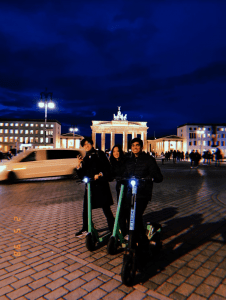 block.
block.  For the nature enthusiasts, hiking is always a cheap option that you can tailor to your experiences and preferences. Many big cities in Europe are located next to mountainous regions or along the coast. For example, if you travel to Marseille in France, you can scale the Calanques for a whole day without spending a single cent. In many of the port cities, you can find rocky outcrops to bask in the sunlight or take a stroll along the beach. If you’re in Italy or Portugal, there are many lakes such as Lake Como or the Benagil Caves that you can spend your afternoon exploring. While extra activities such as mountain biking or sea kayaking may cost 10-30 euros, the views are spectacular and worth the cost.
For the nature enthusiasts, hiking is always a cheap option that you can tailor to your experiences and preferences. Many big cities in Europe are located next to mountainous regions or along the coast. For example, if you travel to Marseille in France, you can scale the Calanques for a whole day without spending a single cent. In many of the port cities, you can find rocky outcrops to bask in the sunlight or take a stroll along the beach. If you’re in Italy or Portugal, there are many lakes such as Lake Como or the Benagil Caves that you can spend your afternoon exploring. While extra activities such as mountain biking or sea kayaking may cost 10-30 euros, the views are spectacular and worth the cost. 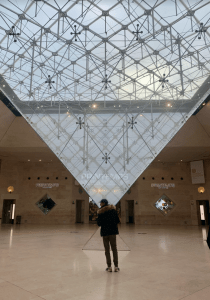 As a student, you’re in luck. Many museums such as the Prado in Madrid are free for students on certain weekends. If they are not free, exhibition tickets are often sold at a discounted rate if you have your ISIC card on you. These museums often hold gems of modern, historical art, and they can eat up a whole day of activities if you’re interested. Not only are these museums specific to the region, they also have different exhibitions every month.
As a student, you’re in luck. Many museums such as the Prado in Madrid are free for students on certain weekends. If they are not free, exhibition tickets are often sold at a discounted rate if you have your ISIC card on you. These museums often hold gems of modern, historical art, and they can eat up a whole day of activities if you’re interested. Not only are these museums specific to the region, they also have different exhibitions every month. 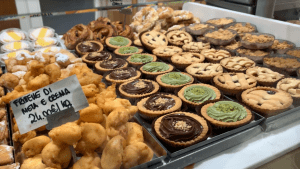 For the foodies, a cheap way to try local foods is to go bakery hopping. Many small goodies cost one or two euros and are pretty filling. They also represent the local cuisine with each baked good. For example, in Faro, Portugal, we tried Portuguese egg tarts that are a euro and custard sponge cakes, which the locals were crazed about. In Italy, we also had cheap cannolis and pistachio buns for under a euro. In Como, they sold pastries by the bag, and we lived off them for only 7 euros throughout the entire day.
For the foodies, a cheap way to try local foods is to go bakery hopping. Many small goodies cost one or two euros and are pretty filling. They also represent the local cuisine with each baked good. For example, in Faro, Portugal, we tried Portuguese egg tarts that are a euro and custard sponge cakes, which the locals were crazed about. In Italy, we also had cheap cannolis and pistachio buns for under a euro. In Como, they sold pastries by the bag, and we lived off them for only 7 euros throughout the entire day. 
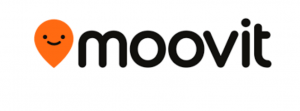
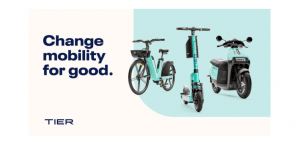

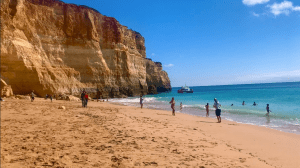
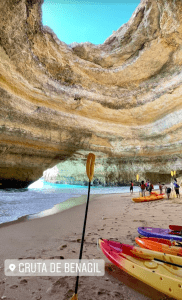 If you want an up close and personal look at caves, go sea kayaking with a guided tour. Those people can help you get to certain landmarks such as the crocodile rock while telling you stories about how the rocks formed. Not only do these tour guides help you dock your kayaks, but they’ll also help you get back on board in case you flip! Sea Kayaking is a great way to be immersed in the natural beauty while paddling close to the water without getting drenched in the cold waters during the winter. You’ll get an adrenaline rush from racing through the waves and get a waft of cool, ocean breeze while basking in the warmth of the sunlight.
If you want an up close and personal look at caves, go sea kayaking with a guided tour. Those people can help you get to certain landmarks such as the crocodile rock while telling you stories about how the rocks formed. Not only do these tour guides help you dock your kayaks, but they’ll also help you get back on board in case you flip! Sea Kayaking is a great way to be immersed in the natural beauty while paddling close to the water without getting drenched in the cold waters during the winter. You’ll get an adrenaline rush from racing through the waves and get a waft of cool, ocean breeze while basking in the warmth of the sunlight. 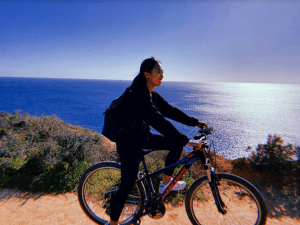

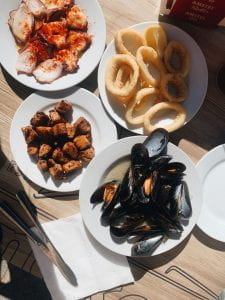
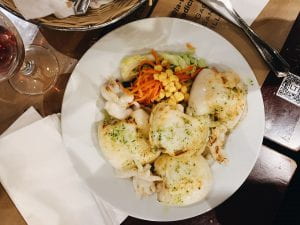
 The skies were a baby pink and pastel blue when we reached the Notre-Dame de la Garde, perched upon a hill overlooking the city. The view was breath-taking. The clear blue waters of the Mediterranean melted into the gentle hues of the sky to create a glowing aura across the land. Against the beautiful backdrop, the city started to wake from its slumber as people slowly filled the streets, each claiming a pastry for a quick breakfast. The random collection of buildings, homes, and even soccer fields created an interesting puzzle of red roofs, white columns, and green patches of land. As I stood along an overlook, I took a deep breath of crisp morning air just as the church clock began to strike. The sound of the resounding gongs and the squawking birds paired with the stunning view and peaceful scenery painted the ideal picture of Marseille into my memory, one so different from any others.
The skies were a baby pink and pastel blue when we reached the Notre-Dame de la Garde, perched upon a hill overlooking the city. The view was breath-taking. The clear blue waters of the Mediterranean melted into the gentle hues of the sky to create a glowing aura across the land. Against the beautiful backdrop, the city started to wake from its slumber as people slowly filled the streets, each claiming a pastry for a quick breakfast. The random collection of buildings, homes, and even soccer fields created an interesting puzzle of red roofs, white columns, and green patches of land. As I stood along an overlook, I took a deep breath of crisp morning air just as the church clock began to strike. The sound of the resounding gongs and the squawking birds paired with the stunning view and peaceful scenery painted the ideal picture of Marseille into my memory, one so different from any others. 